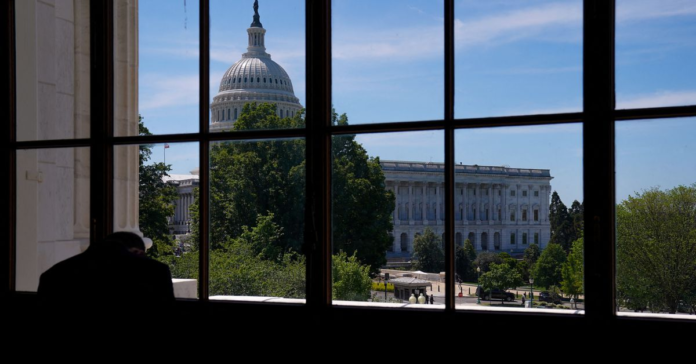The U.S. Capitol dome is seen from the Russell Senate Office Building on Capitol Hill in Washington, U.S., April 19, 2023. REUTERS/Sarah Silbiger/File Photo Acquire Licensing Rights
WASHINGTON, Sept 29 – Lower income households and Black and Latino communities will be hit hard when a confluence of U.S. economic events kick off next week, including a sharp drop in childcare funding, economists, analysts and government officials said.
About 12.4%, some 41 million, of the U.S.’s 333 million people live at or below the poverty line, the Census Bureau calculates, which is set at about $29,678 for a household of two adults and two chidren.
That rate fell to a record low in 2021 thanks to COVID-19 federal support, but has jumped as these programs expired.
SHUTDOWN IMPACTS
Hardline Republicans in the House have rejected a deal the Republican-led House negotiated with U.S. President Joe Biden in May for $1.59 trillion in discretionary spending in fiscal 2024, paving the way for wide swaths of the government to shut down for the fourth time in a decade.
Everything from economic data releases to food benefits may be suspended beginning on Sunday, and some 2.2. million government workers may be furloughed or forced to work without pay.
The average member of the American Federation of Government Employees earns between $55,000 and $65,000 a year, but thousands of hourly workers earn much less, about $31,200 a year. These workers will all get back pay after the furlough or shutdown is over, but contract workers, who earn even less, are not eligible for the back pay.
FOOD BENEFITS FROM WIC, SNAP
A shutdown could cause a rapid loss of food benefits for nearly 7 million low-income women and children on the Special Supplemental Nutrition Program for Women, Infacts and Children, or WIC, U.S. officials said Tuesday.
The $5.7 billion annual program provides food assistance and health care referrals to low-income pregnant, postpartum and breastfeeding woman and children up to age 5 — benefits that could dry up in days.
A separate benefits program, Supplemental Nutrition Assistance Program (SNAP), will continue as normal for the month of October but could be affected afterward, officials say.
More than 40 million Americans relied on SNAP to make ends meet in 2022; inflation has put new pressure on household budgets, with prices higher since the COVID-19 pandemic for goods from bread to fresh vegetables and baby formula.
BLACK COMMUNITIES
Biden said this week that the shutdown would hit Black Americans disproportionately hard, including by reducing nutritional benefits, cutting inspections of hazardous waste sites and lack of enforcement of fair housing laws.
About 13% of Americans identify as Black, but Black participation in SNAP is about double that rate; in WIC it is 22.3%, USDA data show.
U.S. officals say Small Business Administration loans may be delayed and up to 10,000 children could lose access to Head Start, the federal program for preschool children from low-income families. Latino children account for 37% of current Head Start enrollment, with 27% identifying as Black and 24% as white.
Meanwhile, more than 1,400 community health centers serving low-income and rural communities that operate with federal funds could cut staff hours, lay off workers or reduce services, the nonpartisan group First Focus on Children reported.
CHILDCARE, EDUCATION, WORKING PARENTS
Pandemic-era federal funding for the U.S. childcare system will end Saturday and a bill to restart it by Democratic lawmakers, including Senator Patty Murray and Representative Rosa DeLauro, has no traction in Congress.
The AFL-CIO estimates that more than 3 million children will lose access to quality childcare and thousands of providers will be forced to close, lay off childcare workers or reduce slots for children.
US poor face economic hit as shutdown, childcare cliff, student loans converge
RELATED ARTICLES



